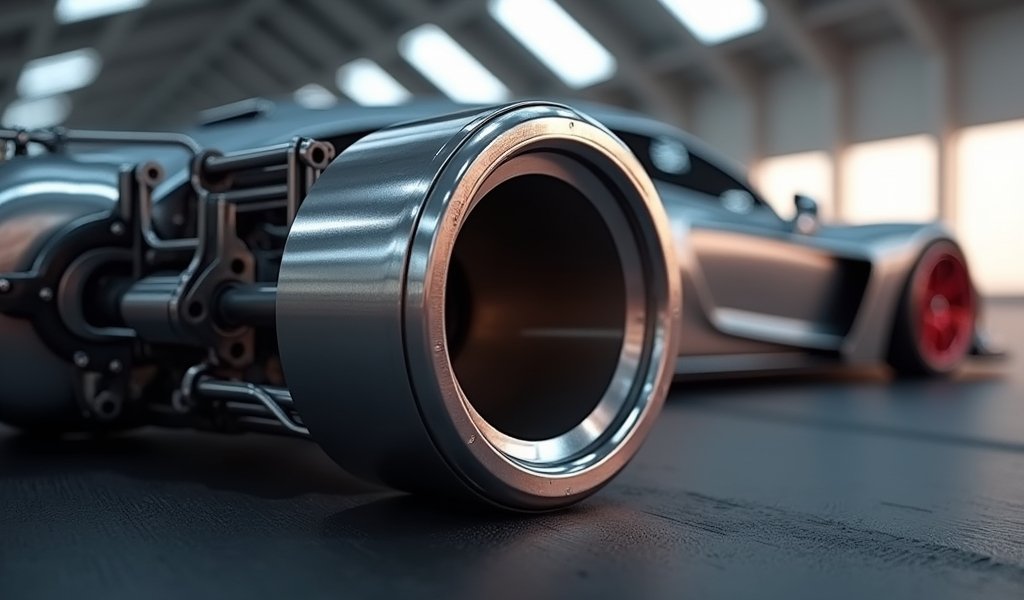Overview
This article explains how throttle body bore diameter affects engine performance, covering symptoms of problems (rough idle, hesitation, poor fuel economy), causes (carbon buildup, electrical issues, wear), and solutions (cleaning, recalibration, replacement). It provides both DIY diagnostic steps and maintenance tips while comparing professional repairs with do-it-yourself approaches for this critical component that regulates airflow to your engine.
Table of Contents
- Understanding Throttle Body Bore Diameter
- Signs of Throttle Body Bore Issues
- Common Causes of Throttle Body Problems
- DIY Diagnosis Steps
- Proven Fixes for Throttle Body Bore Issues
- Professional Solutions vs DIY Approaches
- Maintenance Tips to Prevent Future Problems
- Conclusion
- Frequently Asked Questions
Understanding Throttle Body Bore Diameter
The throttle body bore diameter is like the doorway to your engine’s lungs. It controls how much air can rush into your engine’s combustion chambers, which directly affects performance, fuel economy, and overall drivability. Think of it as the bouncer at the club of your engine’s intake system—deciding precisely how many air molecules get to party with the fuel.
When we talk about sophisticated engine design, few components play such a pivotal yet often overlooked role. The throttle body sits between your air intake and the intake manifold, housing a butterfly valve that opens and closes in response to your gas pedal movements. The diameter of this opening—the bore—determines the maximum airflow potential.
Just like how a garden hose with a larger diameter lets more water flow through, a larger throttle body bore diameter permits more air to enter the engine. But bigger isn’t always better! The ideal size depends on your specific engine design, intended use, and performance goals. It’s a delicate balance that engine designers and professional mechanics spend considerable time perfecting.
Many drivers don’t give their throttle body a second thought until something goes wrong. Yet understanding this component can save you from performance issues and unnecessary repair bills down the road. Let’s dig deeper into what happens when this crucial airflow regulator isn’t working as intended.
Signs of Throttle Body Bore Issues
Your vehicle has its own language of telling you something’s amiss, and throttle body problems come with some distinctive dialects. Like a person with a sore throat struggling to breathe normally, your engine will show clear signs when the throttle body bore diameter isn’t functioning properly.
The most common red flag is a rough or erratic idle. Your engine might feel like it’s doing the cha-cha when it should be standing perfectly still—revving up and down unpredictably while you’re sitting at a traffic light. This dancing tachometer often points straight to throttle body troubles.
Hesitation during acceleration is another telltale sign. If your car responds to the gas pedal like a teenager being asked to clean their room—delayed, reluctant, and underwhelming—your throttle body might be crying out for attention. This hesitation happens because the proper air-fuel ratio can’t be maintained when airflow is restricted or irregular.
You might also notice decreased fuel economy. When the throttle body isn’t regulating airflow efficiently, your engine management system tries to compensate, often by enriching the fuel mixture. The result? Your gas gauge seems to drop faster than your phone battery on a road trip.
The check engine light—that reliable harbinger of automotive woes—often illuminates when throttle body issues arise. Modern vehicles have sensors monitoring throttle position and airflow, and when readings fall outside expected parameters, that amber dashboard light becomes your car’s way of waving a flag for help.
Stalling is perhaps the most serious symptom. Like a conversationalist who suddenly runs out of words mid-sentence, your engine may abruptly quit when throttle body problems become severe. This typically happens at idle or low speeds and can be both annoying and potentially dangerous in traffic.

Common Causes of Throttle Body Problems
Throttle body problems don’t just appear out of thin air—though ironically, air is often the culprit! Let’s explore the usual suspects behind these issues, ranging from the mundane to the mechanical.
Carbon buildup is the throttle body’s arch-nemesis. Over time, the airborne particles, oil vapors, and exhaust gases that naturally circulate in your engine create a sticky residue inside the throttle body. Like cholesterol in an artery, this buildup gradually restricts the effective bore diameter, choking your engine’s airflow. Even a millimeter of buildup can significantly affect performance in this precision component.
Electrical issues represent another common troublemaker. Modern throttle bodies use reliable electronic throttle control systems (drive-by-wire) instead of mechanical linkages. When sensors, wiring, or control modules malfunction, the throttle plate may not open to the correct position, essentially creating a virtual restriction in the bore diameter.
Physical damage can also occur. The butterfly valve might become bent or damaged, preventing it from opening fully or creating an uneven seal when closed. This usually happens during maintenance when tools or cleaning products are used improperly, or in rare cases, from manufacturing defects.
Age-related wear is inevitable. The throttle body assembly contains moving parts that degrade over time. Springs lose tension, bearings wear, and seals harden or crack. These issues can cause erratic throttle response or position, effectively altering the functional bore diameter.
Modifications gone wrong often lead to throttle body problems. In the quest for more power, some enthusiasts install oversized throttle bodies without adjusting other components accordingly. This upsets the carefully calibrated air-fuel relationship, causing the engine management system to struggle with the new airflow parameters.
Environmental factors like extreme temperatures and humidity can also affect throttle body performance. In very cold climates, ice can form in the throttle body, while hot, humid environments accelerate carbon buildup.
DIY Diagnosis Steps
Before you call in the cavalry (or in this case, an expensive mechanic), let’s put on our detective hats and gather some evidence about your throttle body bore diameter issues. With some basic tools and a dash of patience, you can often pinpoint the problem yourself.
Start with a visual inspection—the eyes are an expert mechanic’s most valuable diagnostic tool. With the engine off and cool, locate your throttle body (typically mounted between the air intake tube and intake manifold) and examine it for obvious signs of damage or extreme carbon buildup. A flashlight and small mirror can help you see inside the bore.
Next, check for proper throttle plate movement. With the ignition off, look inside the throttle body while having someone slowly depress the accelerator pedal. The throttle plate should move smoothly from fully closed to fully open. Any sticking, jerky movement, or inability to open completely indicates a problem.
For electronic throttle bodies, a throttle position sensor calibration check can be educational. You’ll need an OBD-II scanner that can read live data. With the engine running, the throttle position percentage should change smoothly as you press the accelerator, with no jumps or flat spots in the readings.
Check for error codes that might illuminate the path to diagnosis:
- Connect an OBD-II scanner to your vehicle’s diagnostic port
- Turn the ignition to the “on” position without starting the engine
- Check for any stored codes related to the throttle body (typically P0120-P0129 range)
- Don’t clear codes yet—they’re valuable clues for diagnosis
Testing throttle response can reveal subtle issues. In a safe, open area with the engine warmed up, gently accelerate from idle. The engine should respond smoothly and immediately. Any hesitation, surge, or lag suggests throttle body problems.
Measure actual airflow if you have access to a scan tool with live data capabilities. Compare the Mass Air Flow (MAF) readings at various RPMs with specifications for your vehicle. Significantly lower readings at the same RPM points often indicate restricted throttle body bore diameter.
Remember, diagnosis is half the battle in fixing throttle body issues. Taking your time here can save you from the “parts cannon” approach—blindly replacing components hoping to hit the actual problem.
Proven Fixes for Throttle Body Bore Issues
Now that we’ve identified the villains in our automotive story, let’s explore the hero solutions that can restore your throttle body bore diameter to its proper glory. These tried-and-true fixes range from simple DIY tasks to more innovative professional repairs.
Throttle body cleaning is often the miracle cure. Like a spa day for your engine’s airway, a proper cleaning removes performance-robbing carbon deposits and restores the original bore diameter. For a DIY approach:
- Purchase quality throttle body cleaner (not carburetor cleaner)
- Disconnect the battery to prevent electrical issues
- Remove the air intake ducting to access the throttle body
- Spray cleaner on a soft cloth and wipe accessible surfaces
- For deeper cleaning, remove the throttle body following your vehicle’s service manual
- Avoid spraying sensors or electrical connections directly
The idle air control valve cleaning often goes hand-in-hand with throttle body maintenance. This valve works closely with the throttle body to maintain proper idle, and cleaning both components together often yields the best results.
For electronic throttle bodies, resetting the adaptation values can work wonders. This process tells the engine computer to relearn the throttle body’s parameters:
- Disconnect the battery for at least 30 minutes
- Reconnect and turn the ignition to “on” position without starting the engine
- Wait 2-3 minutes for sensor calibration
- Start the engine and let it idle for 10 minutes
- Turn off and restart several times
- Drive normally, allowing the system to complete adaptation
In cases of physical damage, replacement is often the most convenient solution. Modern throttle bodies are precision components, and attempting to repair damaged parts usually leads to disappointment. Factory replacements ensure perfect fitment and function, while quality aftermarket options can offer cost savings.
For the performance-minded, throttle body boring is an empowering option. This involves carefully enlarging the throttle bore diameter to increase maximum airflow potential. This modification should only be performed by experienced professionals with proper machining equipment, as precision is crucial.
Installing a throttle body spacer can be a compromise between stock performance and a fully bored throttle body. These devices create an air gap between the throttle body and intake manifold, which can improve airflow characteristics without permanent modifications.

Professional Solutions vs DIY Approaches
When it comes to throttle body bore diameter issues, you’re standing at a crossroads: the DIY path or the professional highway. Both routes can lead to success, but knowing which to take can save you time, money, and potential headaches.
DIY approaches shine in certain scenarios. Basic cleaning and inspection are well within most home mechanics’ capabilities. Like brushing your teeth versus getting a dental deep clean, regular maintenance can often prevent the need for professional intervention. The DIY route typically costs between $10-30 for cleaning supplies versus $100-300 for professional cleaning service.
However, the professional touch brings educational value that extends beyond the immediate repair. Watching an expert work can be like attending a master class in automotive care. Professional mechanics have seen hundreds of throttle bodies and can spot subtle issues that might escape the untrained eye.
The sophistication of modern throttle bodies presents certain limitations for DIY work. Electronic throttle bodies require specialized diagnostic equipment to properly calibrate after service. Without these tools, your DIY efforts might solve the immediate problem but create long-term adaptation issues.
For performance modifications like throttle body boring, professional services are practically mandatory. The precision required to accurately enlarge the bore diameter while maintaining perfect concentricity demands specialized equipment and expertise. A miscalculation of even 0.1mm can lead to performance problems or premature wear.
Time investment is another consideration. What might take a professional 1-2 hours could consume an entire weekend for a DIY enthusiast learning on the fly. As the saying goes, “The expert has already made all the mistakes you’re about to make.”
The middle ground often offers the best value: DIY for regular maintenance and cleaning, professional service for diagnostics, calibration, and modifications. This approach balances cost-effectiveness with technical requirements.
According to throttle body experts, regardless of which path you choose, documentation is crucial. Keep detailed records of all work performed, including cleaning procedures, part replacements, and calibration steps.
Maintenance Tips to Prevent Future Problems
An ounce of prevention is worth a pound of cure—especially when it comes to throttle body bore diameter issues. Following these maintenance strategies can help you avoid the performance-robbing problems we’ve discussed and keep your engine breathing freely.
Establish a regular cleaning schedule based on your driving conditions and vehicle age. As a general rule, consider cleaning the throttle body every 30,000 miles for normal driving or every 15,000 miles for severe conditions (dusty environments, frequent short trips, stop-and-go traffic).
Use quality fuel from reputable stations. Like eating nutritious food to maintain your health, providing your engine with clean, high-quality fuel reduces carbon buildup throughout the intake system, including the throttle body. Premium fuel isn’t necessary unless specified for your vehicle, but consistent quality matters.
Replace the air filter according to manufacturer recommendations. A clean air filter is your throttle body’s first line of defense against contaminants. Most vehicles need a new air filter every 15,000-30,000 miles, but check yours regularly—a visibly dirty filter should be changed regardless of mileage.
Consider using fuel system cleaners with proven PEA (Polyetheramine) content. These additives help reduce carbon deposits throughout the intake system. Adding a quality cleaner every 3,000-5,000 miles can significantly reduce throttle body contamination.
Allow proper warm-up time, especially in cold weather. Cold engines run rich fuel mixtures that contribute to carbon buildup. Rather than extended idling, drive gently for the first few minutes until operating temperature is reached.
Address check engine lights promptly. Early intervention for minor issues can prevent them from escalating into major throttle body problems. Many auto parts stores offer free code reading services if you don’t own a scanner.
When working around the throttle body, be meticulous about preventing debris from entering the intake system. A small piece of tape or clean rag can temporarily block openings during maintenance to keep foreign objects out.
According to engine performance research, maintaining the integrity of your intake system seals also plays a crucial role in throttle body health. Inspect gaskets and O-rings during cleaning, and replace any that show signs of hardening, cracking, or compression.
Conclusion
Navigating the world of throttle body bore diameter might seem like traversing a mechanical maze, but armed with the knowledge we’ve explored, you’re now equipped to handle these issues with confidence. Remember that your throttle body is essentially the gatekeeper of your engine’s performance—treat it well, and it will return the favor with smooth operation and optimal power.
We’ve journeyed through understanding what the throttle body bore diameter actually is, recognizing the warning signs of problems, identifying common causes, and exploring both DIY and professional solutions. Like a good detective story, we’ve uncovered the clues and solved the mystery of throttle body troubles.
The most innovative approach to throttle body issues is often the simplest: regular maintenance. By incorporating throttle body care into your routine vehicle maintenance, you can prevent many of the problems we’ve discussed before they start affecting your driving experience.
Whether you choose the empowering path of DIY maintenance or the reliable expertise of professional service, addressing throttle body issues promptly will reward you with improved performance, better fuel economy, and a more enjoyable driving experience. Your engine will thank you for the attention to this often-overlooked component.
Remember that automotive maintenance is a journey, not a destination. Each vehicle has its unique characteristics, and learning how your specific throttle body behaves over time will make you a more educated car owner. Keep observing, keep learning, and keep your throttle body clean—your engine will breathe easier for it.
Frequently Asked Questions
What exactly is throttle body bore diameter?
The throttle body bore diameter is the interior opening size that controls airflow into your engine. It directly impacts how much air can enter the engine at wide-open throttle, affecting overall performance and power output.
How often should I clean my throttle body?
Most mechanics recommend cleaning your throttle body every 30,000 miles under normal driving conditions. If you drive in dusty environments or make frequent short trips, consider cleaning it every 15,000 miles instead.
Can I drive with a dirty throttle body?
Yes, but you’ll likely experience reduced performance, poor fuel economy, and rough idling. A severely contaminated throttle body could eventually lead to stalling and more serious drivability issues.
Will a larger throttle body always increase performance?
Not necessarily. Oversized throttle bodies can actually decrease performance if not matched properly with other engine components. The ideal bore diameter depends on your specific engine design and performance goals.
Can throttle body problems damage other engine components?
Yes, prolonged throttle body issues can potentially damage oxygen sensors and catalytic converters. Erratic air-fuel mixtures caused by throttle body problems can lead to incomplete combustion and increased emissions.

